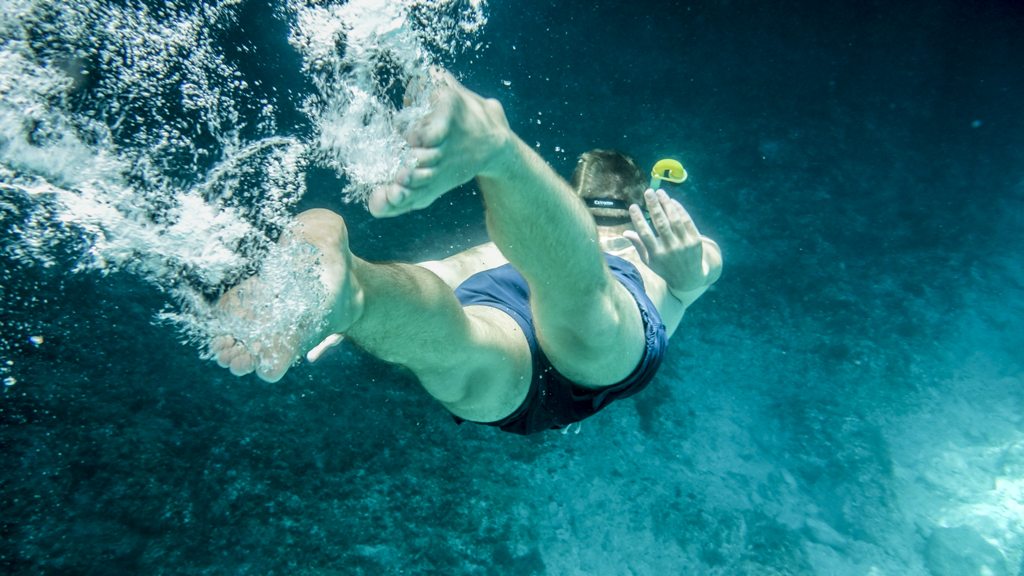The chemicals that make up sunscreen are a recipe for disaster.
In fact, biologists can detect chemicals and minerals that are used to make sunscreen in coastal waters. Because skin cancer is the most common form of cancer in the United States, protecting yourself from the sun is a priority, but as with everything else, there is a cost.
Sunscreen works as a barrier by absorbing ultraviolet (UV) rays including UVA rays which age the skin and UVB rays which cause sunburn. According to researchers at Friends of Hanauma Bay in Hawaii and Executive Director Craig Downs, Ph.D. at Haereticus Environmental Lab, the use of sunscreen has grown exponentially since the 1980’s when sun protection and the fear of UV solar radiation increasingly became a public health focus.
As the world’s coastal population and tourism increases, the expectation that use of sunscreen will also increase as well as cosmetics containing UV-filters. Even though we are protecting our skin and preventing skin disease, sunscreen is not as safe as we think.

Embed This Image On Your Site
<p><strong>Please include attribution to conservationinstitute.org with this graphic.</strong><br /><br /><a href=’https://www.conservationinstitute.org/sunscreen-may-be-dangerous/’><img src=’https://www.conservationinstitute.org/wp-content/uploads/2018/07/TipsForSunscreeProtectCoralReefs.jpg’ alt=’Tips on Sunscreens to Protect Coral Reefs’ width=’700px’ border=’0′ /></a></p>
What ingredients are in sunscreen?
Sunscreen comprises at least 20 chemical compounds and what you probably don’t know is that many of those chemicals have moderate to high toxicity concerns.
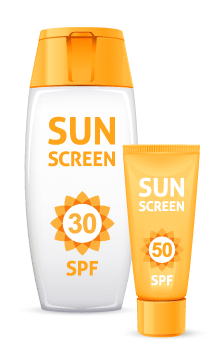
Sunscreen products include chemicals like:
- oxybenzone and octinoxate(UV filters with higher toxicity concerns)
- octisalate, and octocrylene(UV filters with moderate toxicity concerns)
- titanium dioxide, zinc oxide, avobenzone, and mexoryl SX (UV filters with low toxicity concerns)
The Environmental Working Group (EWG), an organization that conducts studies on the chemicals in sunscreen, determines toxicity levels in sunscreen ingredients. They assign a hazard score to each pertinent chemical found in sunscreen.
Chemical vs. Mineral Filters
Filters in sunscreen use different techniques for protecting the skin. The key is to maintain stability while being exposed to sunlight and companies achieve this by using filters. The EWG reports that chemical mechanisms, the most common filters, are UV filters like oxybenzone and octisalate that penetrate both skin layers including the dermis and epidermis. After being absorbed into the skin, chemical sunscreens absorb UV rays from the sun to protect the skin. On the other hand, mineral filters include titanium dioxide and zinc oxide. Mineral sunscreens sit on top of the skin and reflect UV rays. These filters usually exist in the form of nanoparticles which prevent the whitening effect on the skin.
Oxybenzone (chemical)
One of the few ingredients in sunscreen that effectively protects our skin from harmful UVA and UVB rays, oxybenzone is alarmingly dangerous to the environment. This tension has lead to further discussion and debate about whether oxybenzone needs to be eliminated from our skin-care products. According to the American Academy of Dermatology, oxybenzone is safe for humans and has been approved by the FDA since 1978.
Alarmingly so, the Centers for Disease Control and Prevention discovers oxybenzone in more than 96 percent of Americans every year. To add, studies by EWG indicate that the chemical is found in human mother’s breast milk, which means the chemical is traveling to infants through the mother’s skin.

EWG’s 2018 sunscreen database lists oxybenzone as an active ingredient in nearly 65 percent of non-mineral sunscreens. These sunscreens, in particular, use “penetrating enhancers” so that the lotion will stick better to skin. Because of these enhancers, sunscreen chemicals absorb directly into the skin and within in 20 minutes, scientists are able to detect the chemicals like oxybenzone in the urine.
Hazard Scores and Regulation
The Environmental Working Group (EWG) conducts studies to assign a hazard score to the chemicals found in sunscreen. Oxybenzone has a high score of 8 which means the UV filter has the highest toxicity concern. They also note that a hormone disruption occurs when applying oxybenzone to the skin. It weakens estrogen levels and studies continuously link it to altered birth weight. Aside from women and babies, the Endocrine Society reports that eight of 13 chemical sunscreen ingredients allowed in the U.S. affected calcium signaling of male sperm cells in laboratory tests, which the researchers suggest could reduce male fertility.
The U.S. Food and Drug Administration (FDA) regulates sunscreen. Before ingredients can be added to sunscreen the FDA must approve it. Unfortunately, studies are often uncertain about the approved ingredients because most data is generated from animal studies. Therefore, it is difficult to determine the human health implications of exposure to oxybenzone through the application of sunscreen.
Nanotechnology (mineral)
As previously noted, nanotechnology eliminates the white residue that would otherwise stay on the skin. These nanotechnology particles also make it impossible for sunscreen ingredients to enter the body through your skin. In particular, the outermost layer of skin is what prevents nanoparticles from entering further into the body. All of these benefits actually increase UV protection and provides more coverage for the body.
What are Coral Reefs?
Corals are animals with basic immune systems that thrive on the ocean floor. They are the most diverse ecosystems in the world. Even though they makeup less than one percent of the ocean floor, corals provide an essential ecosystem for 25 percent of all marine life.
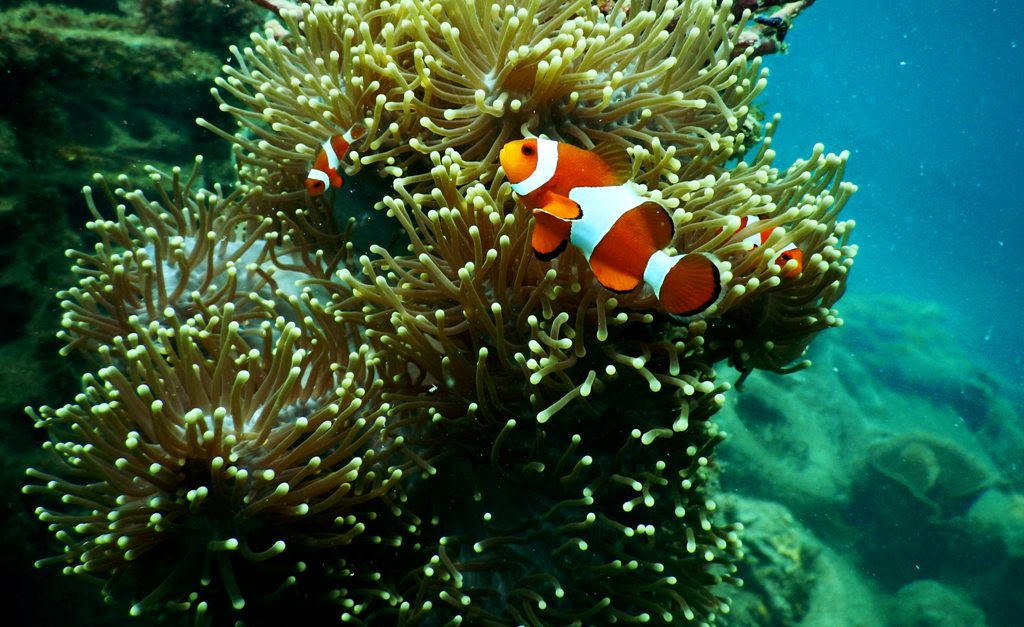
According to National Geographic, polyps build colonies or reefs by secreting calicles or limestone bodies that act as protection. Calicles create colonies and expand into communities that become reefs. In fact, they can grow hundreds of miles long. To date, the largest coral reef is the Great Barrier Reef in Australia which has been growing for 20,000 years.
Important functions:
- Protect young fish as they grow
- Provide food for thousands of human communities
- Produce oxygen and fix carbon
- Increase tourism and therefore income
- Provide biomedical products
- Protect local communities from storms and erosion
What is the link between sunscreen and coral reefs?
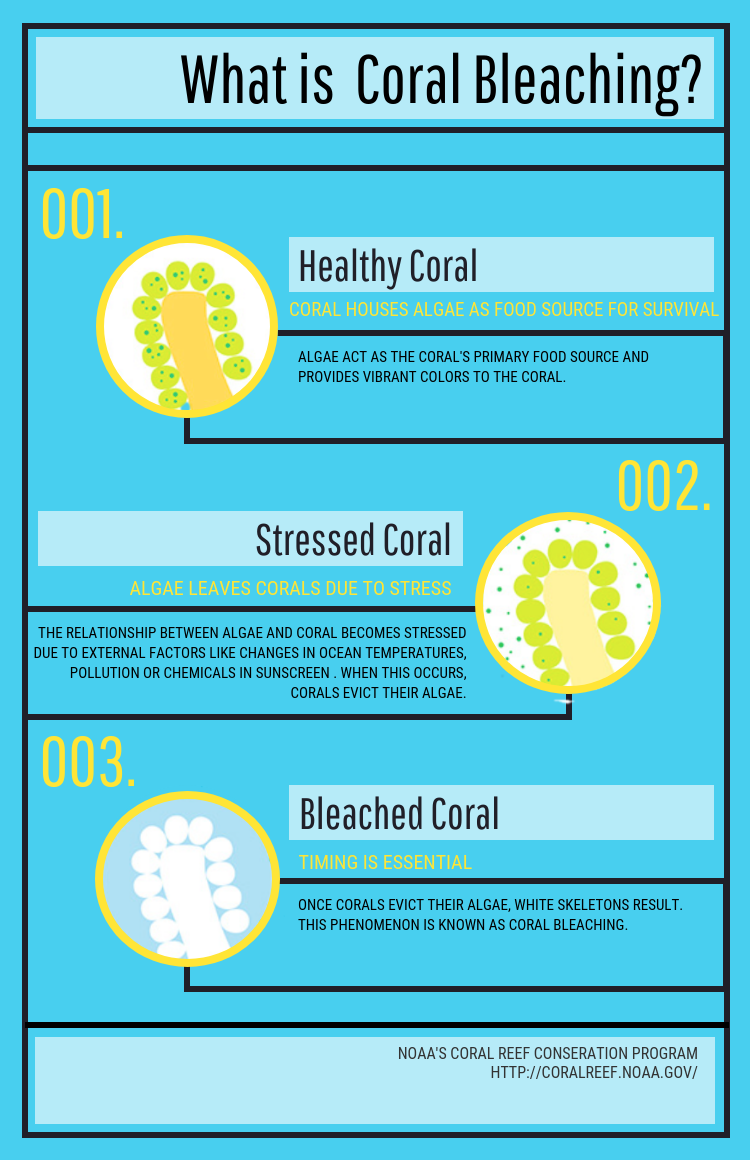
Corals get most of their food from the algae they house. When corals become stressed by pollution, they evict their algae and this results in white skeleton-looking reefs that is otherwise known as bleaching.
While there are many forms of pollution that affect coral reefs, we are going to focus on the chemical noted earlier as oxybenzone which is found in more than 3,500 skin care products across the globe. Most commonly used near coral reefs are sunscreen products.
What’s most concerning about oxybenzone is not the effect is has on humans, but on the corals. According to a report by the International Coral Reef Initiative, corals typically bleach at 81.7 degrees Fahrenheit but oxybenzone causes corals to bleach at 78 degrees, which is non-bleaching temperature. It only takes a few hours for these chemicals to cause serious damage to the corals.

In 2015, the National Ocean Service found that oxybenzone damages juvenile corals and other forms of marine life. A study in the Archives of Environmental Contamination and Toxicology reveals four major toxic effects in early, developing coral:
- Increased susceptibility to bleaching
- DNA damage
- Abnormal skeletal growth (via endocrine disruption)
- Gross deformities of baby coral
A study by the U.S. National Library of Medicine confirms these four major toxic effects that oxybenzone has on coral and also adds to the list. This study notes that oxybenzone infects coral with a virus that contributes to the bleaching process.
How does oxybenzone travel to the corals?
So how is oxybenzone coming in contact with coral reefs in the first place? The Haereticus Environmental Lab estimates that about 14,000 tons of sunscreen is absorbed into water near coral reefs yearly. These UV filters from sunscreen make their way into the ocean waters in a variety of ways that are both direct and indirect.
When people apply sunscreen lotion to their bodies and then go into the water, it washes off and is dispersed into the ocean.
While sunscreen lotions are dangerous, aerosol sprays are even more damaging to the ocean’s ecosystem. The microscopic ingredients are inhaled into the lungs and then released into the air when we breathe. When released into the air through the lungs or sprayed into the air, oxybenzone residue is left on the sand. This residual enters the ocean when the tide moves in and out.
And if you’re thinking that you can just avoid wearing unsafe sunscreen at the beach, consider the situation more carefully. Oxybenzone makes its way into the ocean through wastewater in your home and wastewater treatment plant effluents. This indirect form of oxybenzone travel is what has the largest effect on and causes the most damage to coral reefs.
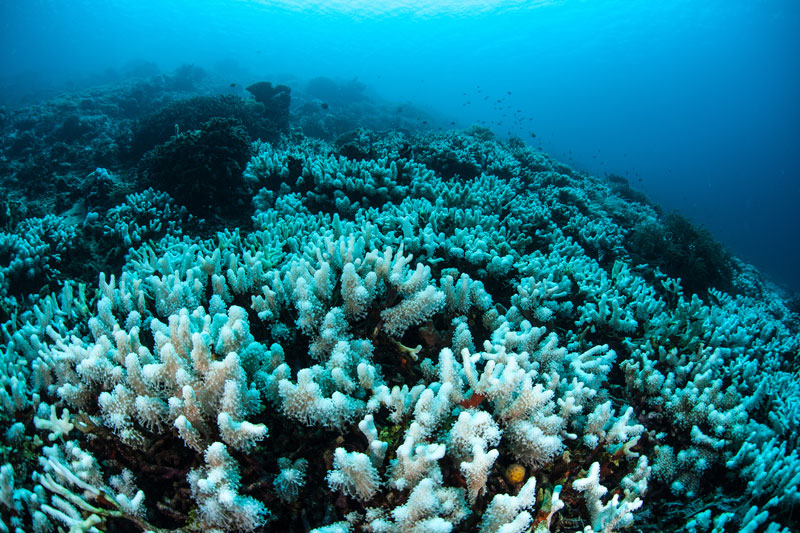
Damage to date:
According to Dr. Craig A DOwns, Ph.D., executive director of Haereticus Environmental Laboratory:
- 85% of the Caribbean coral reefs died before 1999 or 2000
- 40% of coral reefs in the Great Barrier Reef are gone
- 99% of coral reefs in the Florida keys are gone
Implications and Conclusion
Coral reefs are invaluable and crucial to the survival of the human race. According to Haereticus Environmental Lab, coral reefs provide 9.9 trillion dollars each year worldwide. More importantly, they contain cancer-fighting compounds. In fact, we are 300 times more likely to find new drugs from coral ecosystems than land-based ones.
The reefs are also responsible for providing one-fifth of the world’s protein, millions of jobs, and protection to more than 200 million people. Corals act as barriers and protection by canceling out 97 percent of a wave’s strength. The cost to physically make this same type of protection would cost two million dollars in each area that relies on reef protection.
In May 2018, Hawaii was successful in becoming the first U.S. state to pass a bill banning the sale of any sunscreens containing chemicals that damage coral reefs. This new law takes effect January 1, 2019. Aside from that, some companies are beginning to phase out sunscreens containing oxybenzone or focus on creating new alternative sunscreens.
Many coral reefs don’t have enough time to recover and 50 percent of corals were lost in the last 30 years. Help save what’s left of the corals and give them the time they need to adapt to new conditions by avoiding products with oxybenzone today.
View infographic below larger.

